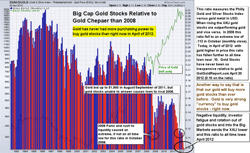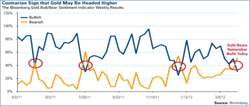HRA Special Delivery #482 - 25 Apr 2012
Don't be a Hater
Eric Coffin
Hard Rock
Analyst
Posted May 5, 2012
That phrase in common use by teenagers these days was the first thing that came to mind when I looked
at the chart below. It was generated by friend and gold market commentator Gene Arensberg who publishes the Got Gold Report which I subscribe to and recommend. It’s a great graphical representation of that hate on for gold stocks lately, as if we needed another reminder.
When I spoke at the Calgary Resource conference early this month I referred to the Venture Index chart as tracing the (hopefully) late stages of the “this market sucks” pattern. I might have made that pattern name up but from the nods in the audience it was clear everyone attending knew all too well what I was talking about. I’ve always found charts to be good at helping to clarify one’s thoughts but not always so great at picking timing. Today’s situation is no different. There are reasons to be encouraged by the charts below but they can’t pinpoint timing of a turn.
Gene’s chart is a stark representation of how many haters are out there in the gold equities space now. The chart depicts the ratio of the level of the Philly Gold and Silver stock Index (the XAU) and the gold price in $US. When the ratio is rising the XAU is outperforming the gold price and vice versa.
(Click on images to enlarge)

The chart is depicting a ratio; the downshift in the ratio post-2008 says as much about equity markets in general as anything. Gold prices moved up quickly through most of this period and equities couldn’t keep pace, especially with production costs rising rapidly. Some of the long term fall is also a function of changing perceptions about how gold producers should be priced. Simply put, as gold prices increased the number of share buyers focused on earnings rather than reserves also increased. Early in this gold bull market gold miners were mainly bought by true believers in bullion. They expected large percentage gains in the gold price and wanted maximum leverage to those price changes. The way to get that was to look for gold miners with the most in-the-ground reserves for your investing buck. Now that gold is north of $1500 far fewer traders expect triple digit gains from current levels and gold stocks are trading more “normally”. P/E ratios for the sector are more closely aligned with the overall market rather than being consistently two or three times higher. Miners recognize this trend which is why dividends are becoming more common and management groups are focused on generating output growth. This reinforces the already growing M&A trend.
When you get to be the size of a Goldcorp or a Barrick it’s all but impossible to generate 20-30% production growth organically. Large companies need to grow through acquisitions but they want to be buying with high priced rather than low priced shares. If management at the large miners expect a bounce in their share prices, and most of them do, they will wait on new acquisitions. This induces a classic “chicken and egg” scenario. Traders buy juniors hoping for a takeover as an exit strategy but they know most majors will want to wait for higher prices on their own shares before making a move. That leaves us in a top down market until we see a sentiment shift. Large and mid-sized gold/silver producer stocks will have a first mover advantage at the turn. Traders who are positioned to make gains off those will be better positioned to take those gains and move into developers and explorers majors might ultimately target.
One view that predicts near term bounce is shown in the following charts below. The top chart is generated from the Bloomberg weekly gold bull/bear survey with a one year gold chart below it. There have been four occasions in the past year, including now, where the number of gold bears (based on gold market participant surveys) exceeded the number of bulls by a significant margin. In the last three cases the gold price rose within a few sessions of the bull/bear crossover. The speed and size of the move varied widely however. The main point is that unless we have moved into some sort of new market paradigm extreme bearishness on the gold price remains a good contrarian indicator.
That still leaves us with a timing issue and the timing issue leaves us, mainly, with Europe. The weekend’s political events added more uncertainty to the picture. In France it looks like socialist Holland will take the runoff election. He is promising to continue fiscal discipline but comments about nutty top tax rates and a commitment to reopen the last Euro fiscal pact (not that it’s working) has traders on edge. Add to that the apparent collapse of the ruling coalition in the Netherlands points to a near term election that will focus on deficit cutting and willingness to support the peripheral countries. As if that wasn’t enough bad news out of Europe for one weekend the latest Purchasing Managers Index for the Eurozone fell enough to freak out anyone who had remained calm up to now.
In a sense, the whole scenario seems depressingly familiar. Eurozone indulges in half measures. Market makes it plain by its trading patterns that it wants to see someone bring out the bazooka. Eurozone politicians try to explain that it’s really not necessary. Market responds – forcefully – that it is. This dance has been going on for three years now. Little wonder so many have withdrawn from the markets.
Short term, renewed calm in Europe that gives the Euro a lift could help precious metal prices. Some sort of fiscal Armageddon might too, but things would be pretty ugly until the dust settled. The one positive note that may come on the political front is that the EU (read Germany) will be forced by new politicians to add some stimulus measures to Eurozone budgets. This seems like a good idea. Obviously, at the end of the day debt levels need to be cut but lopping 3-4% off of the GDP of peripheral countries with budget cuts year after year risks a downward spiral. Northern Europeans may be forced to add some stimulus funds after elections
if only for PR reasons. News that Britain has officially logged a Q4/Q1 recession is sure to generate more political pressure for stimulus there as well. That would help optics if nothing else.
The stand pat message from the Fed is what I expected. Things appear to have slowed a bit in the US but certainly not to the point that requires any sort of panic reaction. Bullion traded well after the announcement thanks to assurances from Bernanke that he would buy bonds again if there was renewed weakness. Gold could have easily been down after a Fed disappointment and the fact it isn’t is positive.
Market sentiment for resource stocks continues to be negative in the extreme. Liquidity is very low and any company unwise enough to issue a news release gets nothing but selling for its trouble. How long this
lasts is anyone’s guess. The one glimmer of hope is a contrarian one. The last time we talked to so many traders and brokers and heard pure negativity was in early 2009. In fact, we’re surprised how many people have recently remarked that the current situation is worse than 2009. The current market is bad but 2009 was a whole different level. The fact that so many are making that comparison indicates a level of despair usually seen near major bottoms. I don’t know how long it will take to start moving off of it but the negativity is so pervasive that I think we must be close. Three or four green closes in a row for gold would be a good test of the current bottom, even if the gains for bullion are small.


In the midst of all this bearishness there were a few company releases. All of them were treated as liquidity events whether the content of the news release justified it or not.
Hopefully we are finally seeing a bottom starting to form. We’ll know soon enough.
Regards for now.
###
Eric Coffin
| HRA - Special Delivery is an independent publication produced and distributed by Stockwork Consulting Ltd, which is committed to providing timely and factual analysis of junior mining and other venture capital companies. Companies are chosen on the basis of a speculative potential for significant upside gains resulting from asset-base expansion, new discoveries and potential for future M&A activity or movement through development to production. These are generally high-risk securities, and opinions contained herein are time and market sensitive. No statement or expression of opinion, or any other matter herein, directly or indirectly, is an offer, solicitation or recommendation to buy or sell any securities mentioned. While we believe all sources of information to be factual and reliable we in no way represent or guarantee the accuracy thereof, nor of the statements made herein. We do not receive or request compensation in any form in order to feature companies in these publications. We may, or may not, own securities and/or warrants to acquire securities of the companies mentioned herein. If we're buying a financing in a company HRA follows we say so and we pay for it with our own cash, the same as you. HRA publications are as much as anything about what I am doing with my own resource investing so if I talk about a company it's safe to assume I own it or plan to shortly. This document is protected by the copyright laws of Canada and the U.S. and may not be reproduced in any form for other than for personal use without the prior written consent of the publisher. This document may be quoted, in context, provided proper credit is given. ©2020 Stockwork Consulting Ltd. All Rights Reserved. | Published by Stockwork Consulting Ltd.
Box 85909, Phoenix AZ, 85071 USA
email: customerservice@hraadvisory.com
website: www.hraadvisory.com
SUBSCRIPTIONS 1-877-528-3958
321gold Ltd

|



